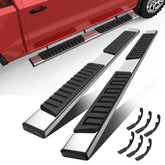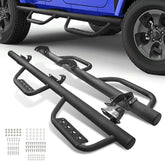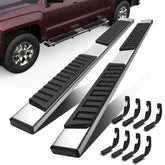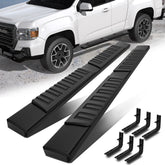Do running boards help with rock chips?
Whether running boards help with rock chips is a common concern among vehicle owners, particularly those who frequently traverse gravel roads or off-road terrain. Rock chips, caused by small stones and debris kicked up by rotating tires, can inflict noticeable damage to a vehicle's paintwork and undercarriage. Many drivers consider installing running boards as a potential solution to address this issue. However, the effectiveness of running boards in mitigating rock chips warrants a closer examination.
Shielding Your Vehicle: How Running Boards Combat Rock Chips
The menace of rock chips poses a persistent threat to the pristine appearance of our vehicles, causing unsightly blemishes and potential damage to the paintwork. In the quest to safeguard our vehicles from this peril, running boards emerge as a possible ally in the battle against rock chips. These robust vehicle accessories are more than just functional additions; they serve as a crucial line of defense, intercepting airborne debris and deterring rock chips from reaching vulnerable areas of the vehicle.
Running boards, commonly installed along the sides of vehicles, extend outward from the door sills and are strategically positioned to intercept rocks and other debris kicked up by the vehicle's tires or passing traffic. By acting as a barrier, running boards help to minimize the impact of these projectiles on the lower body panels, ultimately reducing the occurrence of rock chips along the vehicle's surface.

Preventing Rock Chips: Running Boards Comparison
To discern the effectiveness of running boards in preventing rock chips, evaluating different types of running boards available in the market is imperative. Running boards come in various designs and materials, each offering unique attributes that impact their ability to mitigate rock chip damage.
1. Full-Length Running Boards
- Coverage: Full-length running boards extend along the entire length of the vehicle's cab or passenger area, providing comprehensive coverage.
- Protection: They can effectively shield the lower body panels from flying rocks and debris kicked up by the tires.
- Drawbacks:While offering good protection, full-length running boards can increase aerodynamic drag and reduce ground clearance.
2. Nerf Bars or Side Steps
- Design: Nerf bars are typically smaller and positioned at specific points along the vehicle's sides (e.g., under the doors).
- Limited Coverage: They provide less coverage than full-length running boards, focusing mainly on aiding entry and exit.
- Partial Protection: Nerf bars can still offer protection by diverting rocks away from the vehicle's sides, especially around the doors.
3. Rock Sliders
- Purpose-Built Protection:Rock sliders are heavy-duty metal bars or panels designed to protect the vehicle's body panels from rocks and obstacles encountered during off-road driving.
- Most Effective: Rock sliders offer the highest protection against rock chips and damage among running board options.
- Off-Road Focus:They are trendy among off-road enthusiasts due to their robust construction and ability to withstand impacts.
4. Mud Flaps or Splash Guards
- Complementary Protection:While not running boards per se, mud flaps or splash guards installed behind the wheels can also help reduce the debris kicked onto the vehicle's sides.
- Synergistic Approach:Using mud flaps with running boards can provide comprehensive protection against rock chips.
Optimal Width of Running Boards for Rock Chip Prevention
Wider running boards offer superior coverage, safeguarding a larger area of the vehicle's lower body panels from rocks and debris. This broader coverage minimizes the likelihood of direct impacts on the vehicle's paintwork, reducing the risk of rock chips.
Moreover, the width of the running boards should be proportionate to the vehicle's size and dimensions. Larger vehicles, such as trucks or SUVs, benefit from wider running boards that align with their broader frame, ensuring comprehensive protection against rock chips. Conversely, compact cars may require narrower running boards tailored to their size while providing adequate coverage along the lower sides.

Exploring the Extra Benefits of Vehicle Running Boards
Beyond their primary role in rock chip prevention, vehicle running boards offer many additional benefits that enhance functionality and aesthetics. One notable advantage is facilitating easier vehicle entry and exit, especially for passengers with limited mobility. By providing a stable platform near the door sills, running boards offer added convenience and safety, particularly in adverse weather conditions.
Running boards contribute to the vehicle's overall aesthetics, accentuating its profile and adding a touch of rugged elegance. They are customizable accessories available in various finishes and designs to complement different vehicle styles and personal preferences. This versatility allows vehicle owners to enhance the visual appeal of their vehicles while reaping the practical benefits of rock chip protection.
In summary, running boards emerge as versatile accessories that shield vehicles from rock chips and enhance accessibility and aesthetics. By evaluating different types and widths of running boards, vehicle owners can make informed decisions to safeguard their cars while ensuring optimal ground clearance and off-road capabilities when venturing into rugged terrains.

Related Question
Do running boards hinder ground clearance and off-road capabilities?
While running boards may slightly reduce ground clearance, especially in vehicles with lower ride heights, their impact on off-road capabilities is contingent on various factors, including the design of the running boards and the specific terrain being navigated. Running boards are often engineered to be durable and resilient, capable of withstanding moderate impacts and maintaining functionality during off-road excursions.
Installing running boards should be based on a comprehensive assessment of individual needs and preferences. Selecting running boards designed for rugged use and optimized dimensions becomes imperative for those prioritizing rock chip protection without compromising ground clearance or off-road capabilities.
How do rock chips occur?
Rock chips are caused by small stones or debris kicked up by vehicles, hitting and chipping the paint on a vehicle's lower panels.
What provides better protection against rock chips?
Mud flaps or splash guards behind the wheels are more effective at reducing the debris that gets kicked up and hits the vehicle's lower panels.
How can I minimize rock chips on my vehicle?
In addition to mud flaps, keeping a safe distance from other vehicles, particularly on gravel roads, and applying a protective film or coating to vulnerable areas can help reduce rock chips.
Are there alternative accessories for rock chip protection?
Yes, products like a clear bra or paint protection film can be applied to vulnerable areas of a vehicle to provide a barrier against rock chips.
Featured Products
- $198.99
- $198.99
- Unit price
- / per
- $198.99
- $198.99
- Unit price
- / per
- $203.99
$203.39- $203.99
- Unit price
- / per
- $198.99
- $198.99
- Unit price
- / per














